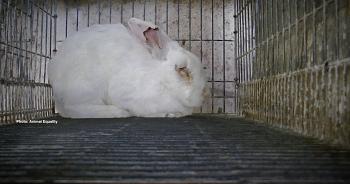Easter not so Happy for Rabbits Raised for Meat in Canada
It’s popping up in pastas, sausages, even dumplings in restaurants across town. Rabbit meat is being hyped as the new gourmet white meat of choice – and planet-friendly, too.
Treehugger.com, the New Yorker, Vogue and homesteader magazines have talked up its sustainability. And a recent Lancaster University study suggests rabbit’s low carbon footprint could trim 30 kilos of Co2 bloat from a meat eater’s diet, prompting the UK’s Daily Mail to exclaim “Help save the world… ditch lamb for rabbit!”
But a new Mercy for Animals (MFA) campaign says there’s nothing ethical about the way rabbits are raised for meat in Canada, with less animal welfare protection than all the other meat on your plate.
“The cages are so tiny, in fact, that rabbits can’t even extend their ears when sitting upright,” says MFA's petition on Change.org.
Rabbit meat has never been an easy sell in North America, the way it is in Italy, Spain or North Korea (true story). Blame it on the Easter Bunny – and all of us who grew up with rabbits as pets.
Still, about 670,000 rabbits were slaughtered for meat in Canada – much of that in Ontario – in 2015, up 13 per cent from the previous year. Rabbit meat is now turning up on more Toronto menus.
But unlike other farm animals, Canada hasn't had any codes of practice – not even voluntary ones – when it comes to raising rabbits for meat.
The National Farm Animal Care Council (NFACC) started developing a code in 2015 and recently released draft recommendations for public comment on minimum space requirements, managing sick or injured rabbits and transport to slaughter. NFACC recommends any new cages be a minimum 45 centimetres high and up to half a square metre for a mature buck, large enough, the group says, to allow rabbits room to lie down, groom, turn around and sit upright.
NFACC’s Jackie Wepruk contends “the draft code already addresses many of Mercy for Animal’s concerns.” But while the the worst cages used to house rabbits by the industry are supposed to be phased out by 2018, most won’t be out of use completely until 2037, roughly when conventional battery cages are supposed to be gone from egg farming operations.
MFA VP Matt Rice isn’t comforted by what he’s seen so far. Like other NFACC codes, the guidelines will be voluntary in Ontario. Furthermore, the code doesn’t mandate a system of enforcement or third-party animal welfare auditing, like with organic farming operations.
Says Rice, “For these standards to mean anything, they must be requirements that carry appropriate penalties for non-compliance.”
MFA wants NFACC to require that rabbits be housed in cages with platforms and nesting materials (which NFACC promises to deliver to 85 per cent of laying chickens within 15 years), as well as options for rabbits to engage in more natural behaviour (including basics like hopping).
Haviva Lush, executive director of Rabbit Rescue Incorporated, a southern Ontario-based charity, has seen what happens without any protections in place for rabbits. She's rescued meat rabbits that were missing limbs, covered in abscesses "with pretty much every disease a rabbit could get."
“Reality is,” says Lush, “rabbits suffer more than most animals, not only due to no codes of practice, but because they do not need to be rendered unconscious before they are strung up for slaughter.”
As for rabbit’s growing rep as new planet-saving “ethical meat,” Lush isn’t buying it. She advises going vegetarian, or better yet vegan if you’re serious about saving the planet.
Read More..Comments
There are 0 comments on this post







